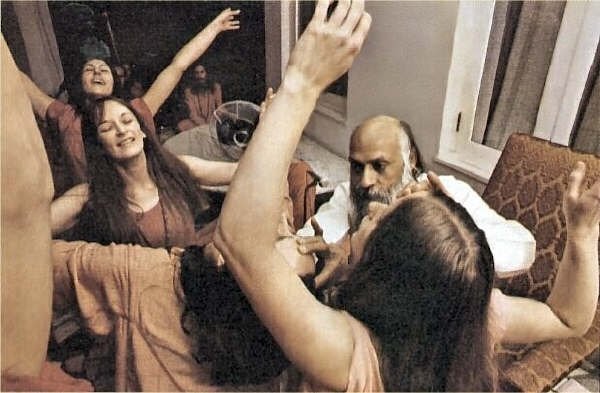If one becomes ecstatic, blissful, one loses silence, because ecstasy, after all, is a beautiful kind of excitement. It is a disturbance — lovely, but a disturbance all the same.
Blissfulness brings its own chaos, its own turmoil, its laughter, its tears, its creativity, its song. And one is bound to get tired of it — it is exhausting. You cannot be ecstatic all the time. Sooner or later you would like to move to the other polarity: silence.
Ecstasy is the logical end of all that is beautiful, passionate, intense, but because it is such a peak of passion and intensity you cannot remain on that peak for long. You have to go back into the deep, dark valleys of silence to rest, to sleep, to get nourished, to be rejuvenated.
Hence the desire for silence arises, a tremendous desire for silence, and of course it feels as if you are going to lose all your creativity, all your joy. And from the peak of ecstasy, silence naturally looks empty and the very idea of moving into silence seems to be suicidal — alluring, enchanting, seducing, but suicidal too, because you will lose your song, your dance, and a sadness arises.
But even if the sadness arises one has to go to silence; one has to move to the dark valleys which LOOK empty, which LOOK like death. Hence the fear, the scary feeling.
Those who have tried to live on the peak of ecstasy have remained only poets; they have not been able to become mystics. A few people have tried, but then they have to find a certain kind of relaxation on the peak. Hence all the poets, all the creators — painters, dancers, singers — sooner or later become attracted towards intoxicating drugs, because the excitement is too much. One has to forget it all.
Either you move to the silent valley, or you can remain on the peak but fall into deep oblivion.
It is not just an accident that since the very ancient days of the RIG VEDA the poets have always been interested in some kind of psychedelic drugs. In the RIG VEDA it was SOMA, now it is LSD or marijuana; all kinds of drugs have been used by creative people.
The logical reason is that nobody can live continuously in excitement — it will kill you. If you don't want to move into silence, then the only way to avoid the constant, passionate, feverish state is through some intoxicant — alcohol, opium, or whatsoever it is.
The people who have moved to the silent valley, who have lived in silence, become afraid of going to the peak of ecstasy because they start feeling that once they move to the peak of ecstasy they will lose their silence. These are the monks; the monasteries were created for these people.
These people moved into hidden caves in the Himalayas and other mountains, not to come back into the world, not to relate, not to love, not to live. They lived only at the minimum so that the silence they have achieved can be preserved, but then they become cold.
In the beginning it looks very cool, but soon it starts getting colder and colder.
They become almost dead.
The people who live in the monasteries are dead people. If you are not creative you cannot be alive. Life can have only one meaning and that is creativity.
God is ultimate life, hence he is the ultimate creator. If you want to live intensely, totally, fully, wholly, you have to create, you have to relate, you have to love, you have to be multi-dimensional.
In a monastery people live a one-dimensional, flat kind of life.
Of course there is no excitement, hence they are not tired, but because they are just sitting there without any songs arising in them, without any spring ever visiting them, they become deserts, empty deserts.
This has been one of the most significant problems for all the meditators: either you choose silence, but then you become dead, cold, unloving, hard, frozen, or if you choose creativity, you live an intense life, passionate, but very tiring.
My effort is to bring these two polarities into your life together. If you ask me to define meditation, I would define it as the art, the alchemy of transforming the polar opposites into complementaries. There is no need to choose. One should be liquid, fluid, flexible, to move from one pole to the other, knowing that they are supportive to each other, they are not against each other; they are not enemies, they are friends.
Just as electricity cannot exist without the positive and the negative poles, just as the day cannot exist without the night, just as life cannot exist without death, creativity cannot exist without silence. And vice versa is also true: silence cannot exist without creativity.
And my own experience and observation is this: that a life which has both is REALLY a whole life, and I don't see any real problem except the old conditioning of centuries. Thousands of years of programming has made the division, otherwise there is no division.
Just as you come out of your house when it starts getting too cold inside, out into the sun, or when it becomes too hot outside you move inside into the cool shade… is there any opposition between the two! Do you need great effort to synthesize this coming out of the room and going back into the room?
There is no question at all — you can simply walk in and out. It is your own house, it is your own garden! And the same feet and the same walk takes you out and in, only your direction is different. Sometimes you are facing inwards, sometimes you are facing outwards.
And one thing to be remembered: when you are capable of moving easily from the inner to the outer and from the outer to the inner you transcend duality, you are no more caught in duality.
And the transcendence cannot happen by choosing one of the two; that is not transcendence, that will be clinging.
OSHO


